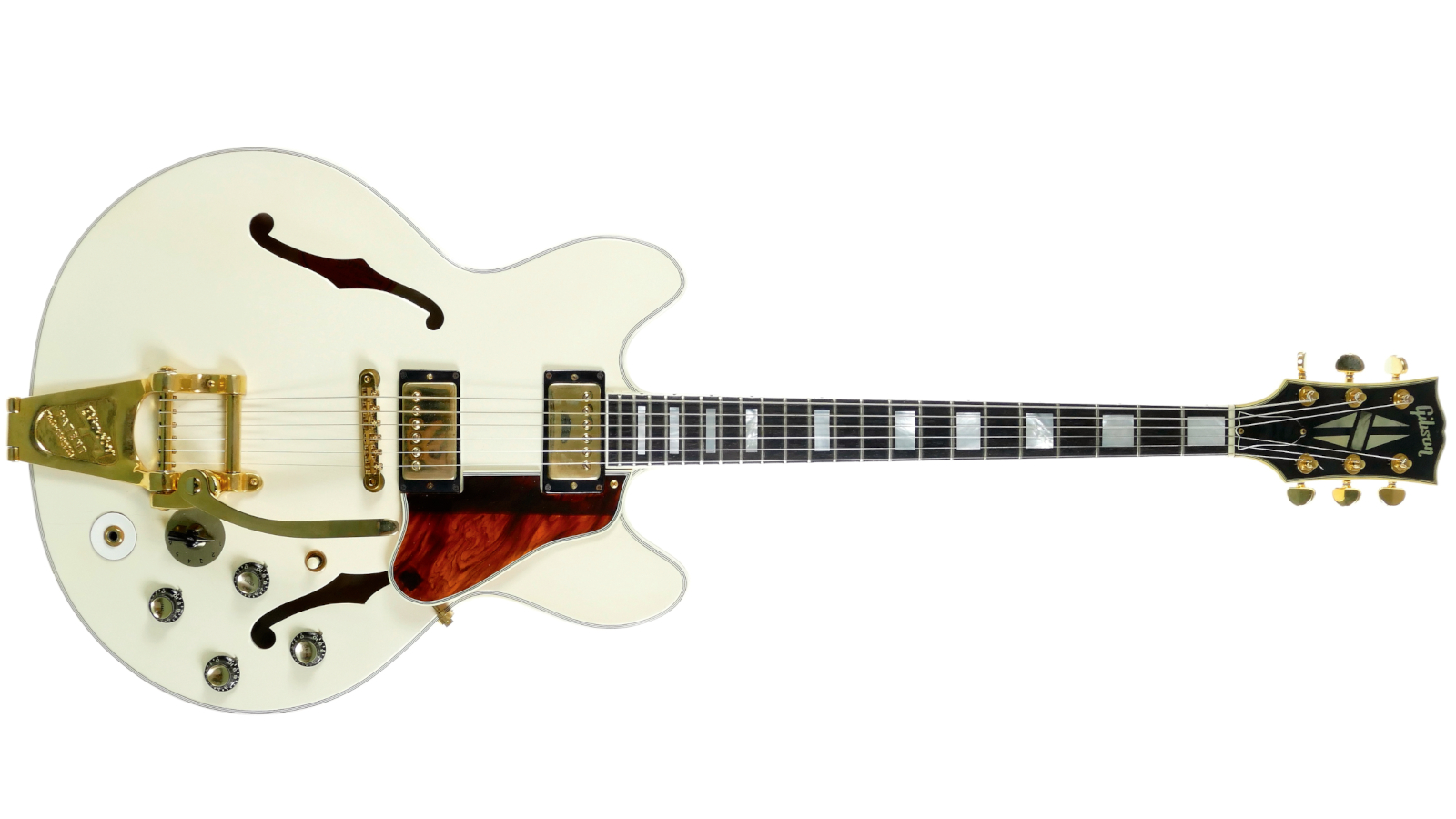The Gibson ES-355 was the Cadillac of Classic Thinline Semis
This rare ES-355TD-SV from 1967 features a Polaris White custom color finish.

The 355 first appeared in 1958 [as the mono ES-355TD] and is just a more ornate version of the 335 semi-hollowbody. Gibson basically put on the whole Les Paul Custom trim: the ebony ’board with the real mother-of-pearl blocks, as opposed to the ‘mother-of-toilet-seat’ inlays; multiple layers of binding on both the front and the back of the body; and the gold hardware.
Most 355s are stereo [the ES-355TD-SV released in 1959], and the [ES-355TD] mono versions are very desirable. Most of the early guitars were Bigsby-equipped, and by 1960 they were available with a sideways Vibrola. At one point you could also get them with an ebony-block Vibrola, like a Les Paul SG.

The stoptail models – which are few and far between – are quite coveted. Players like the stop tailpiece guitars because it gives you a better break angle, which helps with the sustain of the guitar, plus you can bend strings more cleanly. If the string is pulled down sharply, like on a stud tailpiece, it’ll bite. And it won’t slide across the saddle – you don’t get that weird pinging sound.
Gibson tried to rectify that in ’62 by changing from metal to nylon saddles. They stayed with that right through the '70s. I actually think they work very well, especially with an ebony ’board, which is a harder wood that tends to brighten the sound of the guitar. The nylon helps to take away some of that shrill high-end. So it serves its purpose. A lot of people think it’s a bad idea, but the engineers over at Gibson knew what they were doing.

The tops and backs of these laminated guitars were steam-pressed with a veneer of maple. The necks are mahogany. The earliest models come with Grover Rotomatic tuners and, in the early '60s, these were superseded by Kluson [Super] ‘waffleback’ tuners.
The Klusons work really well – they’re very well made. Although I have seen some people taking them off and putting Grovers on. There was this whole obsession with Grover tuners in the '70s. People were even putting them on Stratocasters. It was terrible.

This particular guitar was owned by just one person before me. It was specially ordered in Polaris White and it has all of its tags from when it was new. It’s a pretty neat piece and it has virtually no wear. All the gold plating is intact and there’s no verdigris.
All the latest guitar news, interviews, lessons, reviews, deals and more, direct to your inbox!
This one has a laminated input jack ring, which was something you could order, but you don’t see it on that many guitars. I’ve seen it on several 355s, but I like that they took the time to use a white one for this guitar.
It’s a ’67, so it has the narrower nut width: 1 9/16-inch rather than the 1 11/16-inch. It’s a little bit narrower, but it plays very well. And by this stage the fret size was fairly large, so they work really well for rock ’n’ roll and blues guitar players.

This guitar sounds great. By ’67 Gibson were using T-top humbuckers, but I’ll be honest with you, I never really had a problem with T-top pickups – I think they sound great. To me, this is a very good instrument.
It has a sibling – a ’61 355 in Polaris White – that was virtually the same except it had the side-pull Vibrola. I sold it to Joe Bonamassa. That, too, was a wonderful electric guitar. Keith Richards has a white [ES-345], but I haven’t seen a whole lot of them. They didn’t make a lot of custom color 355s. It’s also very hard to get a sunburst 355, but I have come across a ’62 with the Maestro ‘leaf and lyre’ Vibrola.

355s are interesting. Because it was such a high-end instrument, I think a lot of players had more of a hand in how they wanted their guitar to be personalized. It was like instead of driving a Pontiac you got to drive a Cadillac. You know, when you ordered it, it could be customized to some extent. And I have had several artist-owned 355s that were personalized.
One of them had a Super 400 headstock with a family crest inlaid into the top. It belonged to a blues guy from Alabama. I also had a 1960 cherry 355 that was made for a guy called Bernie Smith with a stoptail. It has white dual pickguards, and each knob had a giant white washer. It also has a plaque that reads "Custom Made for Bernie Smith 1960." That’s a really interesting guitar.
People seem to forget that even back then Gibson had a custom shop, and you could basically draw up what you wanted within reason. And that’s where some of these really wacky special-order Gibsons came from.

Vintage guitar veteran David Davidson owns Well Strung Guitars in Farmingdale, New York.
info@wellstrungguitars.com / 001 (516) 221-0563
Rod Brakes is a music journalist with an expertise in guitars. Having spent many years at the coalface as a guitar dealer and tech, Rod's more recent work as a writer covering artists, industry pros and gear includes contributions for leading publications and websites such as Guitarist, Total Guitar, Guitar World, Guitar Player and MusicRadar in addition to specialist music books, blogs and social media. He is also a lifelong musician.

